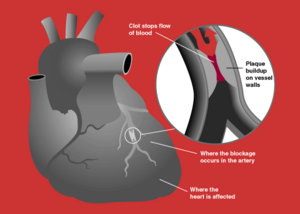Among the highest risk factors are male sex, age over 35, cigarette smoking, high blood pressure, high levels of certain blood fats such as triglycerides, and a family history of cardiovascular disorders.
Other researchers have added to this list another risk factor: the compulsive, hard-driving, highly anxious "type A" personality. The greater the number or severity of the above risk factors, the greater the person’s overall risk.
| Measurement of blood pressure in arm with a sphygmomanometer. (Photo credit: Wikipedia) |
If you smoke a pack of cigarettes a day, your risk of having a heart attack is twice that of a nonsmoker. If you smoke, have hypertension, and eat a diet high in sugar and carbohydrates without any exercise at all, your risk is five times greater than normal.
The Healthy Heart
If these risk factors endanger the heart’s health, what enhances its well-being and improves its odds of working long and well?
Obviously, quitting smoking and eating a balanced healthy diet will help. The next best thing you can do for your heart’s sake is to give it what it needs: regular exercise and in particular, the right kind of exercise, such as cardio interval training.
The heart is a muscle, or, more accurately, a group or “package” of muscles, similar in many ways to the muscles of the arms and legs. And just as exercise strengthens and improves limb muscles, it enhances the health of the heart muscles as well.
Since World War II, several large-scale statistical studies have evaluated the relationship between physical activity and cardiovascular disease. One well-known survey compared 31,000 drivers and conductors of several bus companies. The more sedentary drivers had a significantly higher rate of heart disease than the conductors, who walked around the buses and climbed stairs to the upper level.
The why and how behind these statistics were best explained by classic experiments with dogs whose coronary arteries were surgically narrowed to resemble those of humans with arteriosclerosis. Dogs who were exercised had much better blood flow than those kept inactive.
The exercise seemed to stimulate the development of new connections between the impaired and the nearly normal blood vessels, so exercised dogs had a better blood supply to all the muscle tissues of the heart. The human heart reacts in the same way to provide blood to the portion that was damaged by a heart attack.
| An example of how a heart attack occurs. (Photo credit: Wikipedia) |
With all these facts in mind, the question becomes, how do we strengthen the heart muscle and keep it healthy, and help it develop these new connections if it is already damaged?
A number of studies have shown that moderate exercise several times a week is more effective in building up these auxiliary pathways than extremely vigorous exercise done twice as often.
The general rule is that exercise helps reduce the risk of harm to the heart. Some researchers further attested to the link between exercise and a healthy heart based on the findings that the non-exercisers had a 49% greater risk of heart attack than the other people included in the study. The study attributed a third of that risk to sedentary lifestyle alone.
By employing cardio interval training, you can absolutely expect positive results not only on areas that relate to your cardiovascular system but on the overall status of your health as well.
This type of activity consists of a cycle of “repeated segments” of intense nature. These segments are separated by periods of recuperation to allow the heart rate to return to normal. This not only strengthens the heart muscle, but as you can imagine, it more closely mirrors the nature of human activity. Most people don't move at a constant high rate of intensity. Your body just wasn't designed for that. It is much more natural for you to experience a high rate of exertion for a short time, followed by a period of rest.
Consequently, engaging in this type of activity can bring you many more positive results than you may have previously experienced from steady-state exercise. These are:
1. The threat of a heart attack is lessened - sometimes quite drastically
2. Enhanced heart strength and ability to handle bursts of activity - for example, shoveling snow or moving heavy objects
3. Increased metabolism and increased calorie burn, even after you're finished with your workout, which leads to easier and faster weight loss
4. Improved lung capacity
5. Helps lessen or eliminate stress
Indeed, cardio interval training is one of the best ways to create a healthy, happy heart and body.




No comments:
Post a Comment